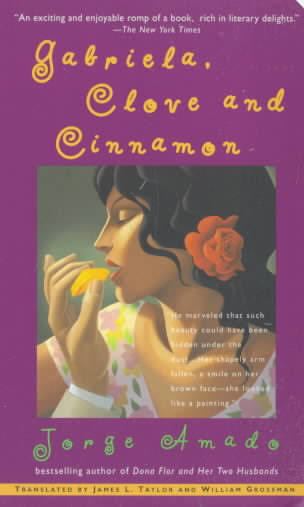8.6 /10 1 Votes8.6
4.6/5 Barnes & Noble | 4.1/5 Goodreads Originally published 1958 Genre Romance novel | |||||||||||||||||||||||||||||||||
 | ||||||||||||||||||||||||||||||||||
Similar Jorge Amado books, Romance novels | ||||||||||||||||||||||||||||||||||
Gabriela cravo e canela jorge amado 59
Gabriela, Clove and Cinnamon (Portuguese: Gabriela, cravo e canela) are two Brazilian Modernist novels. It was written by Jorge Amado in 1958 and published in English in 1962. It is widely considered one of his finest works. A film adaptation of the same name was created in 1983.
Contents
Plot summary
Gabriela, Clove and Cinnamon is a romantic tale set in the small Brazilian town of Ilhéus during the 1920s. The town is experiencing a record large cacao crop, which makes it a thriving place and gives it an economic upswing and great progress. Still there is a conservative streak among the town folk and they are still relying on old traditions, like violent political takeovers and vengeance against unfaithful women. The book tells two separate but related tales: first, the romance between Nacib Saad, a respectable bar owner of Syrian origin, and his new cook Gabriela, an innocent and captivating migrant worker from the impoverished interior. The gap between the worlds of Nacib Saad and Gabriela make their romance a challenge to the unwritten rules of Ilhéus society and will subsequently change the two of them forever.
The second part to this story is about the political struggle between the seasoned cacao plantation owners, with the powerful Bastos clan in pole position, and the forces of modernization, in the person of Mundinho Falcão, a wealthy young man from Rio de Janeiro. It can be read simultaneously as an unusual, charming love story, a description of the political and social forces at work in 1920s Brazil, a somewhat satirical depiction of Latin American aspirations to "modernity", and a celebration of the local culture and pleasures of Bahia.
Theme and settings
Gabriela, Clove and Cinnamon gives the reader a peek into a small town community on the brink of a grand transformation. Ilhéus is an inviting little place with a good mix of culture and quite a few originals to tint everyday life. In the mid-1920s, the Brazilian provinces suffer under the political, social, and economic dominance of the cacao plantation owners – the "colonels" (Portuguese: coronéis). They sit at the very top of the societal structure and control the region, having the absolute majority of the political power. In this story though, there is a new kid in town, Mundinho Falcão, a man who recently moved to Ilhéus from Rio de Janeiro. He has a sole purpose: to seize the political power from these "colonels". The town patriarch, Colonel Ramiro Bastos, disapproves of the outsider's interference and vows not to surrender without a fight.
The colonels run the local governing administration of both major political parties, thus control all decisionmaking and with violence if necessary hold on to their large estates that supply the means upon which everything and everyone depends. They are the plutocratic rulers of what could be called a purely feudal society, aided by complicated system of allegiances built upon mutual interest, reciprocal favors and kinship.
Adaptations
The book was made into series for Brazilian television in 1960, in 1976 and again in 2012. A feature film of the novel was directed by Bruno Barreto in 1983. The feature version starred Sonia Braga as Gabriela and Marcello Mastroianni as Nacib, and featured original music by Antonio Carlos Jobim.
